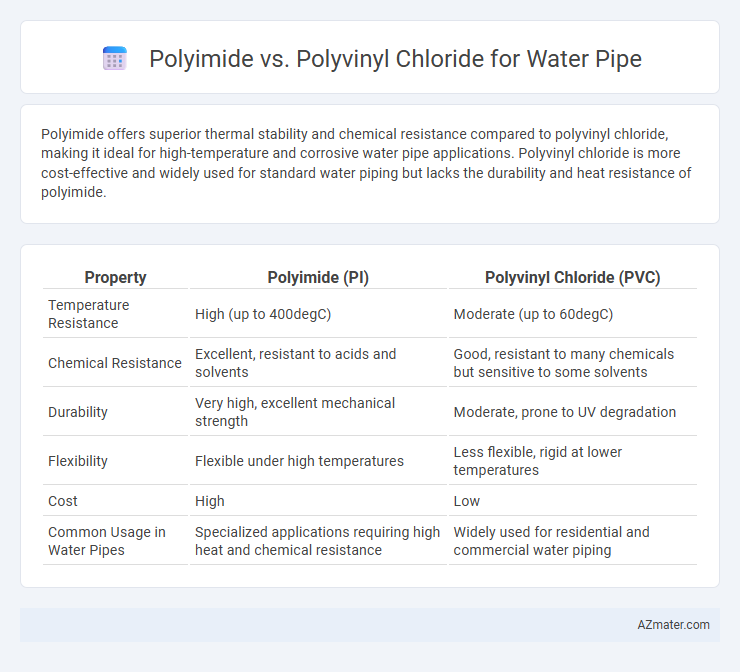Polyimide offers superior thermal stability and chemical resistance compared to polyvinyl chloride, making it ideal for high-temperature and corrosive water pipe applications. Polyvinyl chloride is more cost-effective and widely used for standard water piping but lacks the durability and heat resistance of polyimide.
Table of Comparison
| Property | Polyimide (PI) | Polyvinyl Chloride (PVC) |
|---|---|---|
| Temperature Resistance | High (up to 400degC) | Moderate (up to 60degC) |
| Chemical Resistance | Excellent, resistant to acids and solvents | Good, resistant to many chemicals but sensitive to some solvents |
| Durability | Very high, excellent mechanical strength | Moderate, prone to UV degradation |
| Flexibility | Flexible under high temperatures | Less flexible, rigid at lower temperatures |
| Cost | High | Low |
| Common Usage in Water Pipes | Specialized applications requiring high heat and chemical resistance | Widely used for residential and commercial water piping |
Introduction to Polyimide and Polyvinyl Chloride Pipes
Polyimide pipes offer exceptional thermal stability, chemical resistance, and mechanical strength, making them suitable for high-performance water transport applications requiring durability under extreme conditions. Polyvinyl chloride (PVC) pipes are widely used in water systems due to their affordability, corrosion resistance, and ease of installation, especially in residential and municipal plumbing. Both materials provide reliable solutions for water piping, with polyimide excelling in specialized industrial environments and PVC dominating general water supply networks.
Chemical Composition and Structure
Polyimide (PI) is a high-performance polymer characterized by aromatic imide groups providing exceptional thermal stability and chemical resistance, while polyvinyl chloride (PVC) consists of vinyl chloride monomers with a chlorine atom enhancing its rigidity and flame resistance. The imide rings in polyimide form a highly stable, planar, and conjugated molecular structure, leading to superior mechanical strength and resistance to aggressive chemicals compared to the linear, chain-like structure of PVC. PVC's molecular structure, featuring polar chlorine atoms, offers effective barrier properties and cost efficiency, but it is less resistant to high temperatures and harsh solvents compared to the aromatic backbone and imide groups found in polyimide.
Mechanical Strength and Durability Comparison
Polyimide water pipes exhibit superior mechanical strength with high tensile modulus and exceptional resistance to deformation under stress compared to polyvinyl chloride (PVC). The durability of polyimide pipes surpasses PVC due to their outstanding thermal stability, chemical resistance, and ability to withstand harsh environmental conditions without brittleness or cracking. PVC pipes, while cost-effective, degrade faster under UV exposure and temperature fluctuations, leading to reduced lifespan and mechanical performance in long-term water transport applications.
Temperature and Thermal Resistance
Polyimide outperforms polyvinyl chloride (PVC) in water pipe applications due to its superior temperature and thermal resistance, withstanding continuous operating temperatures up to 260degC compared to PVC's maximum of around 60degC. The high glass transition temperature (Tg) and excellent thermal stability of polyimide ensure long-term durability under extreme heat conditions, preventing deformation and degradation. In contrast, PVC softens and loses mechanical integrity at elevated temperatures, limiting its use in high-temperature water systems.
Corrosion and Chemical Resistance
Polyimide exhibits superior corrosion and chemical resistance compared to polyvinyl chloride (PVC), making it ideal for water pipes exposed to aggressive chemicals or harsh environments. Its high thermal stability and resistance to acids, solvents, and oxidation prevent degradation and extend pipe lifespan. PVC, while cost-effective and corrosion-resistant to a degree, is more susceptible to chemical attack and brittleness under prolonged exposure to certain chemicals and temperature fluctuations.
Water Safety and Toxicity Profiles
Polyimide water pipes exhibit superior chemical resistance and thermal stability, significantly reducing the risk of leaching harmful substances into drinking water compared to polyvinyl chloride (PVC) pipes. PVC pipes can release toxic compounds such as vinyl chloride and phthalates, which pose health risks, especially under higher temperatures or prolonged water exposure. The inherently inert nature of polyimide ensures safer water transport by minimizing contamination and maintaining water purity over time.
Installation and Maintenance Considerations
Polyimide pipes offer superior chemical resistance and flexibility, reducing installation complexity in corrosive or high-temperature water systems compared to polyvinyl chloride (PVC), which can become brittle over time in similar conditions. PVC pipes are easier to install due to their lightweight and standardized fittings but require frequent maintenance checks for cracking and UV degradation when exposed to sunlight. Maintenance costs for polyimide are generally lower due to its durability and reduced risk of leaks, while PVC demands routine inspection and potential replacement parts to ensure system integrity.
Cost Analysis and Economic Feasibility
Polyvinyl chloride (PVC) water pipes generally offer a significantly lower initial material cost compared to polyimide pipes, making PVC the more economically feasible option for large-scale water distribution systems. While polyimide exhibits superior chemical resistance, thermal stability, and durability, its high production and raw material expenses limit its cost-effectiveness for common water pipe applications. Cost analysis shows that PVC's affordability and widespread availability result in lower installation and maintenance expenses, solidifying its dominance in the water pipe market despite polyimide's advanced performance characteristics.
Environmental Impact and Sustainability
Polyimide exhibits superior environmental sustainability compared to polyvinyl chloride (PVC) for water pipes due to its higher chemical resistance, longer lifespan, and reduced need for frequent replacement, minimizing waste generation. PVC production and disposal release hazardous substances such as dioxins and phthalates, contributing to environmental pollution and health risks. Polyimide's thermal stability and recyclability further enhance its eco-friendly profile, aligning with green building standards and reducing the overall carbon footprint in water infrastructure.
Ideal Applications for Polyimide vs Polyvinyl Chloride Pipes
Polyimide pipes excel in high-temperature and chemically aggressive environments due to their exceptional thermal stability and chemical resistance, making them ideal for industrial water systems exposed to harsh conditions. Polyvinyl chloride (PVC) pipes are best suited for residential and commercial water supply and drainage systems, benefiting from their cost-effectiveness, corrosion resistance, and ease of installation. While PVC is widely used in standard cold and warm water applications, polyimide pipes are preferred in specialized industrial setups requiring durability under extreme temperatures and chemical exposure.

Infographic: Polyimide vs Polyvinyl chloride for Water pipe
 azmater.com
azmater.com